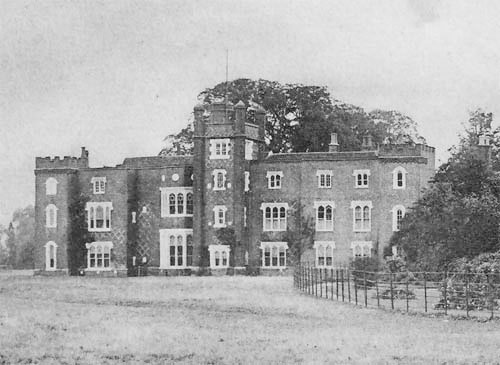Belhus
Essex
| Location | Thurrock | ||
| Year demolished | 1957 | ||
| Reason | Surplus to requirements and damage from WWII requisitioning | ||
| See all images: | Gallery | ||
| << Back to the main list |
Wartime damage took a heavy toll on many houses - and Belhus was no exception.
 Described as 'newly builded' in 1526, this substantial early-Tudor house was built around a courtyard by John Barrett from about 1520. The Barrett family had owned the estate since 1346 and their land-holdings were such that they were the most important family in the Aveley and South Ockenden area. The first owner was one Nicholas de Belhus whose son, Thomas, married Elizabeth de Norton. Their daughter, Alicia de Belhus, married John Barrett of Hawkhurst in Kent in 1401. It was their great-grandson, another John, who created the Belhus demolished in 1957.
Described as 'newly builded' in 1526, this substantial early-Tudor house was built around a courtyard by John Barrett from about 1520. The Barrett family had owned the estate since 1346 and their land-holdings were such that they were the most important family in the Aveley and South Ockenden area. The first owner was one Nicholas de Belhus whose son, Thomas, married Elizabeth de Norton. Their daughter, Alicia de Belhus, married John Barrett of Hawkhurst in Kent in 1401. It was their great-grandson, another John, who created the Belhus demolished in 1957.
Apart from the demolition of the substantial gatehouse in 1710, The house underwent no major changes until the 17th Lord Dacre, Thomas Barrett-Lennard, (b. 20 April 1717, d. circa 12 January 1786) indulged in some fashionable 'gothic-isation' between 1744-1777. Among the changes he made, the west range became the new entrance front with a new entrance hall with panelling featuring pointed gothic arches and he also installed Flemish early Renaissance doors and surrounds. There are no records to show how exactly how much was the work of architects and how much the owners. The amateur architect Sanderson Miller was certainly advising on the dining room in 1752 and was still involved in 1759 with Timothy Lightoler who was responsible for the moulds for the decorative work. Also as part of the changes, Capability Brown was commissioned in 1754 to redesign the gardens.
Sir Thomas had one daughter but also an illegitimate son - and it was the son, another Thomas, who inherited the house and estate. The illegitimacy broke the line of the Lords Dacre but Thomas Barrett-Lennard was created 1st Baronet Barrett-Lennard, of Belhus, Essex in 1801. His first son, again called Thomas, inherited in 1857, and his son - who, demonstrating the family's imagination for names was also called Thomas, inherited in 1919.
This point marks the beginning of the end for Belhus. The new Sir Thomas inherited aged 66 - and he had no children. Worse, he was already firmly established at Horsford Manor in Norfolk. H. Avray Tipping, writing in Country Life in 1920, wrote of the new Sir Thomas' concern about the fabric and contents of Belhus - an anxiety only heightened by the signs of damp in some rooms. Tipping's concerns were realised when in August 1922 it was announced that the house and estate were to be sold. In May 1923, 1,600 lots over eight days emptied the house of its generations of contents. The sales raised a total of £19,187 - or about £750,000 in today's money.
Sir Thomas died the same year and the house passed to his brother Richard, who himself died in 1934, leaving the house to his son - also Richard, the 5th Baronet. The son had been living in Belhus in 1933 but appears to have left in 1937 to concentrate on the Norfolk estate. In that year Essex County Council bought 600 acres to add to the Green Belt - but ended up building a housing estate on part of the purchase. The mother-in-law of the 5th Baronet continued to live in Belhus until it was requisitioned at the start of World War II.
The war effectively finished off the house. The house suffered some bomb damage - but equally as destructive, the troops stationed there had used some of the fine panelling and the oak floorboards for firewood. Estimates to repair the damage were in the region of £35,000 - equivalent to around £1m today. The family were unable to meet the costs and so never moved back into the house. Despite enquiries no other use for the house could be found and so, in February 1957, the demolition men started work.
Of the house itself, only a faint outline of the foundations can now be seen in the middle of a golf course. Some of the sixteenth-century panelling was installed in Valance House Museum in Dagenham, whilst other fittings, including an oak fireplace and panelling from the South Drawing Room and a painting of the house from around 1700, can be seen in Thurrock Museum in Grays.